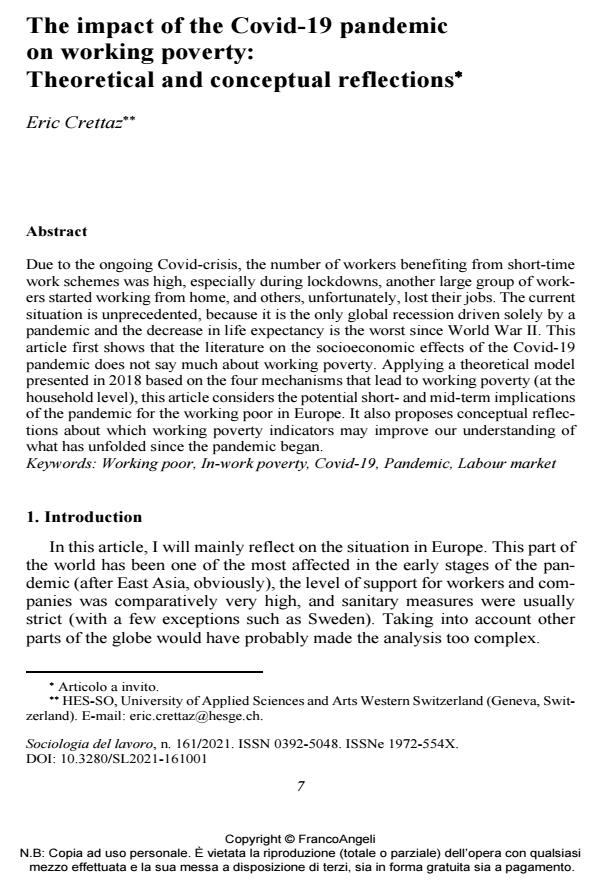The impact of the Covid-19 pandemic on working poverty: Theoretical and conceptual reflections
Titolo Rivista SOCIOLOGIA DEL LAVORO
Autori/Curatori Eric Crettaz
Anno di pubblicazione 2021 Fascicolo 2021/161
Lingua Inglese Numero pagine 18 P. 7-24 Dimensione file 222 KB
DOI 10.3280/SL2021-161001
Il DOI è il codice a barre della proprietà intellettuale: per saperne di più
clicca qui
Qui sotto puoi vedere in anteprima la prima pagina di questo articolo.
Se questo articolo ti interessa, lo puoi acquistare (e scaricare in formato pdf) seguendo le facili indicazioni per acquistare il download credit. Acquista Download Credits per scaricare questo Articolo in formato PDF

FrancoAngeli è membro della Publishers International Linking Association, Inc (PILA)associazione indipendente e non profit per facilitare (attraverso i servizi tecnologici implementati da CrossRef.org) l’accesso degli studiosi ai contenuti digitali nelle pubblicazioni professionali e scientifiche
Due to the ongoing Covid-crisis, the number of workers benefiting from short-time work schemes was high, especially during lockdowns, another large group of workers started working from home, and others, unfortunately, lost their jobs. The current situation is unprecedented, because it is the only global recession driven solely by a pandemic and the decrease in life expectancy is the worst since World War II. This article first shows that the literature on the socioeconomic effects of the Covid-19 pandemic does not say much about working poverty. Applying a theo-retical model presented in 2018 based on the four mechanisms that lead to working poverty (at the household level), this article considers the potential short- and midterm implications of the pandemic for the working poor in Europe. It also proposes conceptual reflections about which working poverty indicators may improve our understanding of what has unfolded since the pandemic began.
A causa della crisi generata dalla pandemia da Covid-19, molti lavoratori hanno beneficiato di programmi di lavoro a orario ridotto (i cosiddetti short-time work schemes attivati soprattutto durante i periodi di lockdown), alcuni lavoratori hanno potuto lavorare da casa e altri, purtroppo, hanno perso il lavoro. Questa situazione è senza precedenti: quella attuale è la sola recessione globale generata unicamente da una pandemia che ha determinato il calo dell’aspettative di vita più significativo dopo la Seconda guerra mondiale. Questo articolo mostra innanzitutto che la letteratura sugli effetti socioeconomici della pandemia da Covid-19 non si è sistematicamente occupata di povertà lavorativa. Utilizzando un modello teorico presentato nel 2018, basato su quattro meccanismi che portano alla povertà lavorativa (a livello familiare), l'obiettivo dell'articolo è quello di considerare le possibili implicazioni di breve e medio periodo della pandemia per i working poor in Europa. L’articolo propone inoltre una riflessione sugli indicatori di povertà lavorativa che possono supportare una comprensione più articolata di ciò che è accaduto dall’inizio della pandemia.
Parole chiave:lavoratori poveri, povertà da lavoro, Covid-19, pandemia, mercato del lavoro
- Chat digitali per il contrasto delle povertà relazionali: apprendimenti dalla valutazione quali-quantitativa di un intervento sociale Arianna Santero, Monica De Luca, Samuele Poy, in RIV Rassegna Italiana di Valutazione 92/2025 pp.75
DOI: 10.3280/RIV2025-092005
Eric Crettaz, The impact of the Covid-19 pandemic on working poverty: Theoretical and conceptual reflections in "SOCIOLOGIA DEL LAVORO " 161/2021, pp 7-24, DOI: 10.3280/SL2021-161001